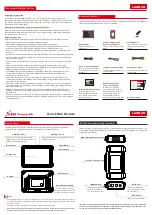
Page
25
the view.
12. Once the process is complete you can click on any of the small EQ graphs to expand them
and to check the filters or to manually tweak him to your own liking. Page 18
13. Once you are satisfied with the results, you can close out the SRO screen, and save the
preset. Also thru the EQ screen you can save the EQ setting to other presets.
Guidelines on microphone setup
Typical small diaphragm measurement microphones have an Omni-directional response pattern
over most of the audio band with a slight narrowing of the pattern as frequency of approach 20 kHz
Most speakers on the other hand, have an Omni-directional pattern only at frequencies below
1kHz. Based on these characteristics, here are some general guidelines on setting up
measurement microphones
1.
The height of the microphone should be placed at ear level.
2.
Most of the frequency response problems in rooms are related to standing waves
and boundary effects which occur at frequencies below 1KHz, and typically below
200 Hz. If this is the main area the user wants to focus on, the exact aiming of the
microphone to the speakers is noncritical. The mic can be pointed at the speaker, or
an angle of 45°, or straight up.
3.
If you're interested in correcting frequencies over the full audio bandwidth, and the
mixing position is within 1m to 2 meters, you should point the microphone towards
the speaker for best results.
4. In larger rooms, where the speakers are many meters away from the mixing position,
the direction the microphone is pointing is less critical, and the recommended
microphone position is pointing up approximately 45°.
In all cases, if you are unsure of your microphone placement you should do a couple trial
measurements with different microphone positions to see which gives you the best response.








































